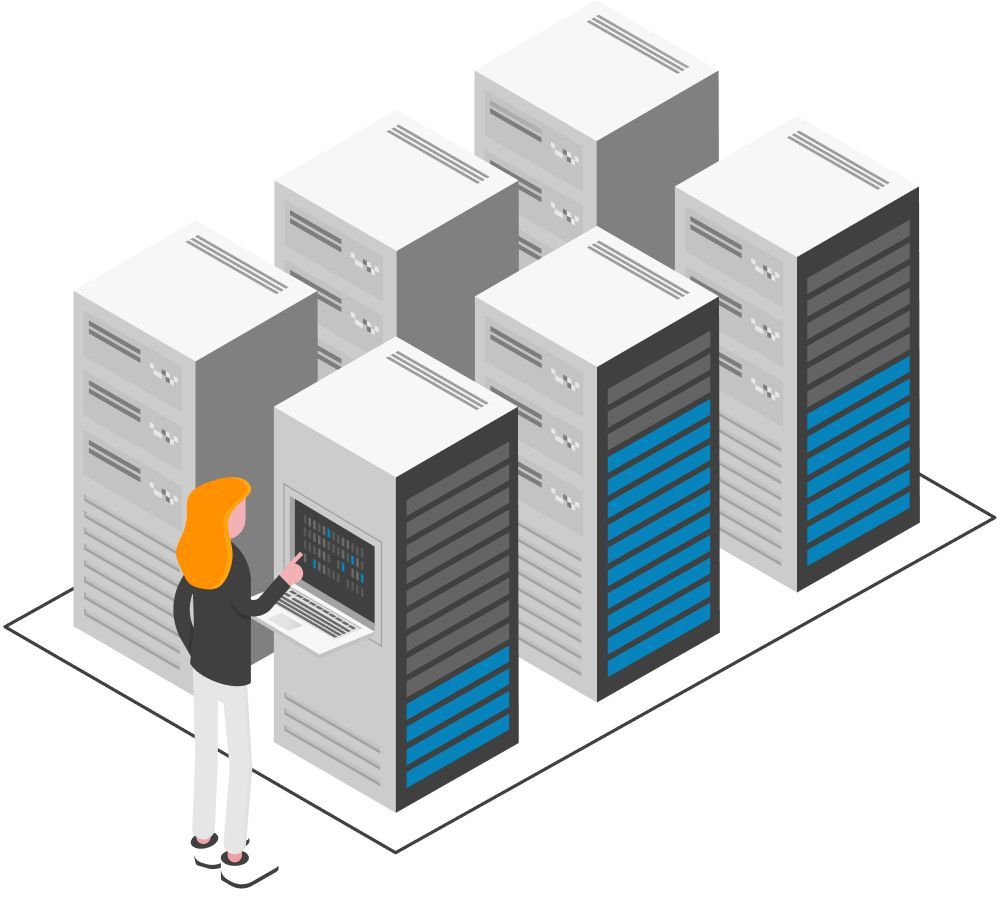Co-location service (“colocation”) is a service for the hosting companies' own servers in the data centers specially equipped for it.
The provision of such a service carried out by firms’ owners who rent and sublease the computer rooms by post and by unit, as well as by data centers themselves.
Literally, “Co-location” means “united deployment” of equipment by autonomous customers in a single data center. Colocation appropriates when a company has a server equipment where it plans to host a commercial project. At the same time it isn’t possible to provide the suitable conditions for placing this equipment in the office, or when the capacity of a virtual server (or the several virtual servers) is no longer sufficient to provide necessary performance and further build-up of the "virtual capacities" is economically disadvantageously and unprofitable.
What does a service consist of?
Colocation usually includes the following set of services:
- placement an equipment in a data center rack;
- connection a communication channel and delivery an IP address;
- organization a remote access to equipment (IPMI, iLO, iDRAC);
- power supply, but usually with a single source;
- required climate regime;
- physical security;
- "Smart Hands" or "Remote Hands" - equipment maintenance services (reboot, disk installation, etc.);
- round the clock monitoring.
Some services provide with an additional fee (for example, protection against DDoS attacks or access to the Internet at a high speed).
Classification the data centers or how to choose a reliable data center?
During choosing a data center for own equipment, it is recommended firstly pay attention to TIER - the infrastructure and equipment reliability standard assigned to the data centers.
Depending on TIER level the data centers divide into four groups:
- TIER I – the minimum level of reliability where the engineering infrastructure and, in particular, the power supply isn’t backed up – it’s means the failure of the entire system in case of a force majeure;
- TIER II – the active elements of a system supply with the additional (redundant) components reducing the risk of a critical failure;
- TIER III – the data centers with the systems where all elements reserved in such way that a "hot" technical work can be carried out without shutting down the client's equipment;
- TIER IV – is the highest level of reliability where the data center has two fully working infrastructures - the main and a backup.
Most commercial data centers are TIER II or TIER III.

Co-location means co-location by autonomous customers of equipment in the data center.
During the choosing a data center of a certain category, it should to understand whether a data center with a declared TIER category or a confirmed one considers. Confirmation of TIER level is a presence of corresponding certificate from the Uptime Institute. Only a data center with confirmed certification can guarantee the declared level of service quality. By the way, for our clients we offer colocation in the data centers only at TIER III level.
What does the cost include?
Each server needs a co-location, but for the large online stores and sites with a high load, for commercial portals and SaaS applications, for hosting “heavy” business applications, this is a mandatory requirement. So, you need to be prepared for the costs of Co-location.
The cost of hosting co-location servers depends on the following parameters:
- level of data center’s reliability – first of all, it is necessary to assess desired level of the data center’s fault tolerance. If there are no increased requirements for fault tolerance and the few hours of downtime per month will not lead to the significant losses. Then TIER-II category will be optimal. The cost of a placing equipment in TIER-II data center is usually lower than in TIER-III one. If it is important to ensure complete continuity of operation and potential downtime minutes will lead to the large losses, it recommends to place the equipment in TIER-III category the data center;
- number of units – the cost of Co-location directly depends on a number of the rented units in a server rack. Therefore, for calculating a price it is necessary correctly calculate how many units will be required. During the calculating, it is important to take into account all equipment and communications that are planned to be placed in a rack. Its include not only the server itself, but also the cables, cable organizers and the patch panels. All of these items often have a 19-inch rack form factor that means they will require the additional units. For saving money it possible to rent the units for them without connected a power - usually such options are present in the tariffs of providers;
- power consumption – if you plan to rent an entire rack, you need to calculate the total amount of power per rack. If you need only few units, only than a power of active equipment is calculated. It should remember that the power of the equipment changes during its operation - it decreases when the load reduced and increases when it rose. Most providers offer a certain amount of power (300 - 400 W) when renting a unit, and additional power provided as a separate service package;
- width of the communication channels – it is necessary to determine a number and a width of the channel: concrete speed, the ports and the amount of channels’ traffic will be required. Some data centers offer a discount with ordering the several channels at a time;
- number of IP addresses – protection against DDoS attacks doesn’t fall under the responsibility of a data center. It is necessary to provide their own means of protection. Some sites provide this service for the communication channels within the proposed tariff plans, but usually up to the L3-L4 level;
- presence of protection against DDoS attacks – most tariffs include 1 IP address and several technical ones. An additional number of IP addresses purchased in the separate service packages. A distinction made between IPv4 and IPv6 versions. IPv6 addresses are much cheaper than IPv4, and for some providers they are completely free;
- provision of the additional services – installation of equipment, providing access to it and remote maintenance on a ticket from a client.
How much does Co-location cost?
In the reliable data centers the cost of renting one unit is average $50 per month. This price includes up to 350 W of power, a communication channel with a speed of 100 Mbps, 1 IP address. Some providers have DDoS protection enabled by default.
And the cost of a 5-kilowatt 42-inch rack is from $1,000 per month, again, in reliable data centers. If you choose the simple data centers, the renting a rack will be much cheaper.
Pros and cons of hosting a server in a data center
Of course, placing a server in a data center has more advantages than disadvantages. Among them:
- right server climate stably maintained for comfortable operation of the server equipment;
- lack of dust, even finely dispersed;
- stable power supply, preferably with two independent connection beams;
- unlimited traffic at a stable speed - either 100 Mbps or 1 Gbps;
- unlimited access to equipment, both remote and physical;
- an engineer on duty in a data center who will remotely help resolve a client's issue on a ticket.
But the disadvantages are much less. It:
- relatively high subscription fee for placement in the high-level data centers;
- lack of prompt access to a server in the event of the hardware or a component failure.
Speaking of a server access...
For work with a server and using its functions in the colocation systems, the remote access systems to a server use - IPMI, iLO, iDRAC. With their help, you can do anything - reboot the server, check the correct operation of the OS or even update the BIOS.
The remote administration systems require a separate Internet connection or separate access. For such purposes you can purchase an additional IP address with the hosting of remote server management services. This isn’t entirely safety, so some data centers offer their clients an access proxying for free that saves the clients from additional monthly costs and hides a server management interface behind a long URL from intruders.
To summarize...
Colocation service is a breath of fresh air for your server, especially after the dusty rooms where servers don’t just suffer, but fail. We highly recommend placing servers in the professional data centers. So, the equipment works for the benefit of your business and solves your problems for a very, very long time.
If you need help choosing a data center to host a server, please contact us. We will help, we will tell, we will advise. For free.





